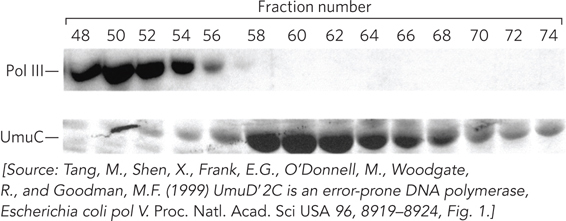DATA ANALYSIS PROBLEM
Tang, M., X. Shen, E.G. Frank, M. O’Donnell, R. Woodgate, and M.F. Goodman. 1999. UmuD′2C is an error-
Question 12.18
Myron Goodman and colleagues discovered the E. coli DNA polymerase V, the first example of a translesion DNA polymerase, using a reconstituted system including Pol III, the UmuD′ and UmuC proteins, and RecA protein. A control experiment was carried out in which Pol III was left out of the reaction mixture, and translesion DNA synthesis still occurred. This was the first suggestion that UmuC and UmuD′ might have DNA polymerase activity, but more work was needed to prove it.
Suggest why the control experiment might not be definitive.
Goodman and colleagues cultured E. coli cells that expressed Pol V, using a strain with mutations giving rise to both an inactivated Pol II and a temperature-
Suggest why the investigators did not use a strain with a completely inactivated Pol III.
The researchers partially purified Pol V and then carried out a gel filtration experiment to separate Pol III from Pol V. Their results are shown in Figure 1, a Western blot analysis of the fractions from the gel filtration column, using antibodies to the α subunit of Pol III and to UmuC.

Three fractions—
Suggest why DNA polymerization is greater for fraction 56 than for fraction 50.
Why does the DNA polymerization activity decline in fractions 50 and 56 at 47°C relative to 37°C?
The activity of fraction 64 does not decline with increased temperature. Suggest why.

448